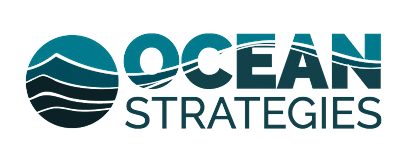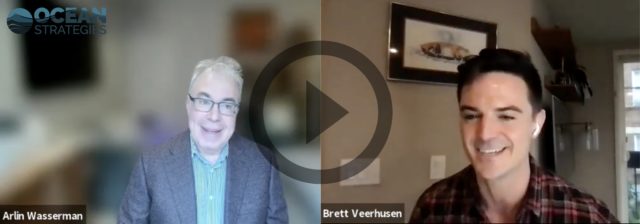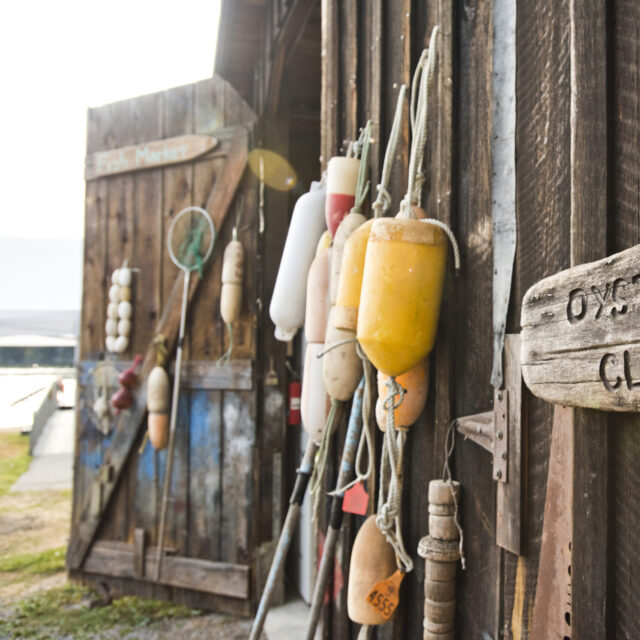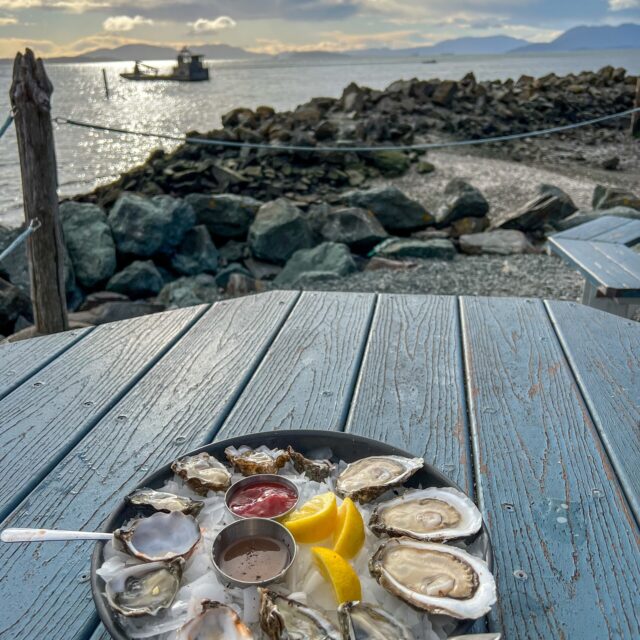Ocean Strategies recently chatted with Arlin Wasserman, founder and managing director of Changing Tastes, a management and culinary consulting firm focused on delicious, profitable, sustainable solutions. We tapped into his expertise to learn more about consumer behavior around seafood, the effect Covid has had on seafood sales, marketing and messaging opportunities, and proposed federal policies that will affect the sustainability of the seafood supply chain. You can contact Arlin at: arlin@changingtastes.net
Click the image above to watch and listen to the full interview with Arlin Wasserman and Ocean Strategies Principal Brett Veerhusen.
Q: Arlin, we’re lucky to have you join us today, thank you. I want to tackle the important questions first — What seafood is on your holiday menu this year and how are you going to prepare it?
A: Well, this is a tricky question because for the first holiday in the last decade I am not the one doing the cooking. The seafood we’ll be having is oysters in the stuffing. We’re not having turkey, because the global supply chain disruptions that we’re cursing every day have resulted in grocery stores being out of stock on about 60% of the turkeys they hope to have. The other thing we’re definitely having is cornish game hens, which is about as close to wild birds as we can get. If this were at the time of the first Thanksgiving, smoked eel was on the menu, along with oysters, bass, and wild birds and game. But not turkey.
Q: I’m familiar with a small commercial eel fishery on the East Coast that’s actually quite lucrative. So they were on to something then! Smoked eel and oysters in your stuffing — that sounds delicious! So this year, we’re certainly lucky to gather with loved ones again. Now, let’s start with a conversation about how the pandemic has impacted consumer behavior. In what ways, Arlin, has Covid changed how we purchase and eat fish and seafood?
A: There’s been a few changes. During most of 2020 and early 2021, before we were vaccinated, how Covid changed how we eat was pretty profound. We basically stopped eating out at restaurants and about 1 in 5 of us determinedly stood in line for take out food and more of us had food delivered to us. Why does this matter? Because up until Covid we ate more of our meals containing fish and seafood in restaurants. And restaurants are also where we try foods we weren’t as familiar with and decide if we like them or not. For instance, before Covid the type of fish and seafood that was being added to menus faster than any other was octopus, not something you necessarily knew how to cook at home. It’s something people love to eat and take pictures of. In fact, octopus consumption in the several years before Covid increased so much in the U.S. that we drove the entire growth in global consumption while the rest of the world ate less of it. That’s another story, another interview.
A lot of people tried to cook a new kind of fish and seafood for the first time during Covid. They might have eaten it a little more frequently at home, but they gave up a lot more eating occasions by not going to restaurants.
The other thing that happened during Covid is that we started to go grocery shopping less frequently. A lot of people used to shop a few times a week, maybe one big shop and then another related to, “what should I have for dinner tonight or what should I have for company tomorrow?” When we went to the grocery store, we would buy fish at the fish counter. It might be fresh fish, it might be previously frozen fish — we like to think of it as “bendable fish” — fish that we could buy and cook within the next few hours. So we would cook one meal with fish and seafood for each time we went to the grocery store.
So during Covid, we stopped eating out and we went to the grocery store less often. Here’s what we found happened — we bought a lot of canned and frozen fish and seafood. And for better or worse, 95% of grocery shoppers, and we did several surveys during Covid, continued the practice of eating one meal of fish and seafood for every time they went to the grocery store. So less frequent grocery shopping meant eating fish and seafood less often.
Other things that are less perishable, like tuna, were already declining in sales dramatically. In the decade before Covid, canned tuna sales dropped by about 30% by unit, which is pretty significant. It’s right up there with Snapple. During Covid, consumers bought a lot of canned tuna and a fair amount of frozen fish and seafood. Here’s the thing though — they didn’t eat it. We surveyed American consumers in April of 2021 and asked them, “in the last 60 days, how many cans of tuna did you purchase, have you eaten any of it, and how many do you have left?” Turns out the more cans of tuna someone bought, the less likely they were to have eaten any of it. And those cans of tuna were being kept for that final meal or maybe because you can throw one to knock out the zombies as they approach your house. No, those are all jokes aside — we didn’t know what the future held and canned tuna is a great shelf-stable food. Unfortunately, what we see now is that we bought all this canned tuna and stored it in our pantries or basements. So now when we want to eat tuna, which we do occasionally, we’re not going out to buy it at the grocery store, we’re digging into inventory. Tuna sales are now below pre-Covid levels, but consumption is about the same.
Through Covid we also found out that Americans really love to eat at restaurants. In June, July, and August of 2021, as warm weather, outdoor dining, the arrival of second shots, and widespread access to vaccinations all came, Americans spent record amounts eating at restaurants, and this was despite restaurant challenges like understaffing. We went right back to eating out. Only last month as the potential fourth wave delta variant came, and cool weather descended in October did that trend stop. The final tally is that September may have been a record month, but October seems to show people in the north eating out a little less.
The number one protein added back to restaurant menus during the four months of record business was octopus. There it is again. When people want to eat out they want to eat things that they can’t cook for themselves at home. Octopus is just now one of those signature items that restaurants offer.
If you think about the reverse — what do people not order out? Things they can pick up at the grocery store. So it’s not a fish and seafood conversation. And if we’re ever discussing manufactured plant-based meat replacements, like Beyond and Impossible, their sales are tanking. We brought them home, thought it was a date, they moved in during Covid, we tried to have dinner with them, and decided it wasn’t a match. So those things we’re no longer buying in restaurants, in fact we don’t like them at all anymore.
Q: So what we’re seeing right now is that people are “hungry” so to speak to get back to restaurants, to get back to normal life, and that we have some really strong seafood sales in restaurants, and in retail it depends on the category — whether it’s fresh or frozen — and canned sounds like a similar trend, packaged or shelf-stable.
A: We use that term, and we might have trademarked it, “bendable fish.” You know what we mean — it’s ready to cook and does not need to be thawed or refreshed in your refrigerator. It’s been thawed in the grocery store and handed to you in bendable form. So the sale of that fish has remained very strong and it’s not great news for the restaurant and grocery industry, it’s maddening for the seafood industry. But the one thing about this ping-ponging between eating out this month or shopping at the grocery store, is that up until a few weeks ago Americans, when faced with food inflation or price spikes due to supply chain disruptions, did not trade down. They kept spending more on better cuts or types of fish or seafood, like fresh or bendable fish fillets, or steaks, or antibiotic free chicken. They did that because they had a choice between spending discretionary food money to eat in a restaurant or in the grocery store to have a great meal. In the last few weeks as food inflation went up 10% per year, now do we see people trading down to cheaper cuts or species.
Q: Let’s talk about marketing seafood. What messages – whether it’s retailer, restaurant, government or fishermen – need to be amplified?
A: We’re continuing to work on this, always trying to figure out how to be a little bit smarter so business can do a little bit better. Right now what we see is that consumers really want to enjoy themselves when they have opportunities. So things that are delicious, things that are unusual, things with visual appeal, dishes you can share with others at your table, are all ways to drive fish and seafood sales.
The other thing that we’ve seen, is that because Americans are less comfortable or unfamiliar about how to cook fish and seafood, they are more likely to eat it out. In terms of increasing consumption, the other thing that restaurants can do is move fish and seafood from the appetizer to the entree. I don’t want to keep talking about octopus, but that’s a move we’ve seen — those servings have increased from 1.5 ounces to 4 ounces. That’s harder to do with fish fillets, steaks, and whole fish, but when you think about other preparations, from ceviche or pickled fish, to small fried mixed fish and seafood dishes, diners are ready to accept bigger portions. Another thing we’ve talked about is that people buy the bendable fish, one meal per visit. We also see tremendous opportunity in cured and smoked fish. If there’s anyone listening to this that wants to get into product development — we are working on this all the time.
Another thing that grocery retailers and others in the seafood industry need to do is show people that this fish and seafood can keep in your home refrigerator and be ready to eat for several days or a week at a time. If you were to buy a bag of hamburgers or chicken breasts, you might thaw that on day one and then eat it again on day three. We don’t think that way about fresh fish, sometimes for good reason. But with smoked and cured fish refrigerated life is quite long and can be a regular mainstay in meals like breakfast and lunch, the two meals where we typically don’t eat as much seafood as often. So that’s another message we think is quite important.
Q: Let’s talk about how consumer behavior around seafood has changed. How have our protein preferences shifted?
A: Here at Changing Tastes, for the last decade we’ve been asking consumers what their eating habits are today and their intentions for the next year or two with respect to protein choices. What we found is that for the last 6-7 years, consumers want to eat less red meat. During Covid that number went up even more to 58%, probably because we’re more aware that we need to take responsibility for our own health. And what we want to do instead has varied. Initially, consumers said the best way to eat less red meat is to have slightly smaller portions of it. So we did that. Changing Tastes introduced and popularized the blended burger with a whole host of other chefs and trade groups and then we became very interested in plant-based meat replacements, which 3-4 years ago were our number one choice — we heard about them, we read about them in the newspaper, we didn’t quite know how to get them — and once we tried them, not so much.
Here’s the reality — we have stopped eating about 10 pounds of red meat over the past decade and replaced it with an even larger amount of chicken. Now yes, our chicken we buy with bones and our meat largely without, so it might be a more even swap. But for the last two years the number one choice Americans have for preference is to replace some of the meat they eat with fish and seafood, which is an amazing market opportunity. We’re going through a once in a generation or two rotation or reconsideration of our protein choices. And without any disrespect to anyone, fish and seafood consumption has gone up partly driven by recalculation in per capita consumption, not by a dramatic increase in sales. Whatever the number was, it got recalculated.
What we find when we dig further, is that American fish and seafood eaters are not homogenous, and diversity is a big deal. It’s a big deal in the marketplace and turns out it’s a big deal in fish and seafood.
There’s a large group of American consumers, baby boomers, facing the start of aging and being told they need to watch their cholesterol, protect heart health, and maintain their brain health. The message about fish and seafood as a healthy nutritious choice really works with most of them. They also happen to be the ones that favor wild fish over farmed fish, and many of them eat fish and seafood twice a week.
But there’s about two-thirds of Americans that eat fish and seafood but don’t eat it that frequently. They might eat it once a month, they might eat it once a week, and they look very different. People who eat it once a month tend to be baby boomers also, often females that live alone and are less concerned or motivated by health. They might look at a different recipe to cook, they’re a little less likely to eat out, they’re looking for some convenience and novelty.
People who eat it once a week tend to be younger, gen-z or millennials. Males in these generations tend to eat out more frequently than the general public; they eat for entertainment and for curiosity. Right now they are eating instead of traveling to experience new things. They are really concerned about ocean health issues, not sustainable fishery management issues, but see eating fish and seafood as a direct connection between the ocean and their body. Microplastics, radiation, animal welfare, labor conditions, and antibiotic use really matters to them. So all of these concerns that have been introduced by the sustainable seafood community as things to work on are now reasons to not eat fish and seafood for a group of people that could eat it more often.
We didn’t mention people who just don’t like fish and seafood. If you’re ever going to go at a way to grow your sales volumes you’d probably start with someone who already eats your product, which is why we’re not going to spend time today talking about that group. They may not eat seafood because they didn’t eat it growing up, they don’t like the taste, or they don’t like the smell in their house. They have lots of reasons, but they never eat it.
Q: So around ocean health — this is interesting because of the work we’ve identified that needs done to harvest a sustainable resource, like addressing ocean plastics and labor conditions — these are related to active pieces of federal policy and legislation, but now that messaging has turned people off. Is there a way to communicate the environmental or ecosystem benefits of eating more seafood than other protein sources?
A: One of the reasons plant-based foods got their audition and that chicken won the race — I’m sure there’s a fable there but I can’t remember which one it is — is because of the general sense that these foods are better than beef. And there’s lot of ways they are better than beef, one of them is animal welfare, another is what we call “clean label” or “clean ingredient.” Chicken producers have eliminated antibiotic use largely in the U.S., and also the environmental footprint. For younger people that is more important and better understood.
The way we often talk about this is — chickens are cute, pigs are smart, cows have a giant carbon footprint — that’s what a lot of people know. Then you ask about fish and seafood and we don’t really have the same conversation. Instead we talk about good fish vs. bad fish and when you make it complex, it’s time to just go eat more chicken.
The growth in chicken consumption is relatively recent. It was about 20 years ago that my business partner and I began working on the issue of antibiotic reduction in livestock production, which most people were not even focused on. For a while the poultry industry used the phrase, “let’s set the record straight.” They claimed antibiotic use is not bad, told people to not believe what they were hearing from Congress or from their doctors, to not believe their own common sense that this is a drug you take when you’re sick, and to not pay attention to the fact that when you give a chicken antibiotics it retains more water and so the industry makes more money. They said, “let’s set the record straight — this is a fine and acceptable thing to do.”
The dramatic increase in chicken consumption occurred when some of the largest manufacturers and producers finally stopped using antibiotics and simply claimed that they had a better product made with care and made responsibly. Purdue was the first to make that change. As 5 of the 6 largest companies did so, chicken sales skyrocketed.
The fish and seafood industry is kind of at the same place the poultry industry was. We’re afraid to look and say, “are there things that we can do better?” and then claim those things. Now we know antibiotic use has become more recognized — 1 in 3 consumers now cite it as a reason they will not buy more fish and seafood. That has to do with farmed shrimp and farmed salmon, especially under intensive growing conditions or in warmer waters.
There are things that we can do better. We might accept some loss for a lot more sales, for instance. Another thing is we still fly our fish around in airplanes, which changes the whole carbon footprint of popular seafood like some farmed salmon. I know there are companies in Norway that have stopped flying their fish around, opportunistic now because with Covid there are fewer flights. So then you can start to claim a really good environmental footprint compared to other protein choices. Given how much fish and seafood we import into the U.S. while we grow almost all of our other proteins, getting the carbon footprint down so there are more favorable comparisons is important for importers.
Right now there are studies being done that show that eating plastic isn’t all that bad for you. It’s an inert material, it comes in and it goes out. Well it also turns out it’s a sponge for hydrocarbons in the ocean so it may be releasing chemicals that cause cancer while it moves through you, but I’m not going to pretend to be a microbiologist. But instead of setting the record straight about whether ocean plastic is good or bad to eat, we could be having a conversation about the wild capture and farmed fish and seafood communities going plastic free or plastic neutral. There are other ways we could directly address consumer concerns, instead of “setting the record straight.”
I don’t think anyone would say there’s harm in putting less plastic in the ocean. In fact it might even be a good thing, it’s the reason we’ve raised this issue in the first place. I think global problems like getting all the microplastics out of the ocean and solving climate change won’t happen in our lifetime. But the industry taking positive steps that make consumers feel empowered when they buy their product could be a great way to move forward on these issues, rather than trying to “set the record straight.”
Another thing is, as Covid has shown us, and unfortunately it’s those same groups that don’t eat fish and seafood as often as they should, about 35 – 40% of Americans don’t believe in science. So setting the record straight is now a scientific argument about scientific facts and whose science is right. And when you do that you get those people who live alone that are older and younger people whose primary source of news may be social media, saying, “those guys and gals are crazy, I don’t trust them and I don’t trust their company so I’m going to eat more chicken or plant-based stuff even though I don’t like it.”
Q: So it’s being proactive instead of setting the record straight and reacting. It’s the messaging of listening and understanding what consumers are concerned about and then addressing that in an honest way.
A: I want to put some boundaries around that. We hear all sorts of things in the news that are fake or false. If someone said “don’t eat salmon, it turns out they’re angels,” or, “don’t eat crab it turns out they’re visitors from outer space and we should welcome them to our table” — we might say, well actually we don’t need to respond to that one in the same way.
But the issues of ocean microplastics, labor conditions, antibiotic use and its impact on ocean life, and worker and fishing community health — these are all issues the fishing community has raised. Ocean microplastics didn’t come from anywhere else, it came from the same groups addressing ocean health, fishery management and other issues, so they’re more credible. The circular firing squad is not the right approach. It’s not as if these came out of left field or are false information or narratives.
Q: There are several fisheries and seafood-related policies currently being addressed in the federal arena, such as the Magnuson Stevens Act reauthorization, the 30×30 initiative, and the AQUAA Act. What sort of policies are most important for ensuring sustainable seafood and responding to consumer needs and behavior?
A: Well I know less about policy as you do, so thank you for giving me the cliff notes on this! I work as a food industry person, I know more about sausage making than the sausage making that occurs in Washington DC. But I do know a little.
The MSA reauthorization is an important part of why Americans would favor buying domestic fish and seafood if it were more available and somewhat more affordable, like Alaska pollock and hake already is. That has to do with management, shorter supply chains, and less substitution that no one knows about. Also a strong belief with good evidence. The labor laws in America are followed more rigorously than in many other countries in the world or on the high seas. So having the best managed fisheries in the world, governed by a strong regulatory system or good rule of law, with no forced labor — all very positive things.
The American livestock industry is still in a regulatory dance around antibiotic use, and some of those measures could help the aquaculture industry as well. If we allow more offshore aquaculture maybe we get the cleanest and best regulated industry in the world. Then we start to have more domestic fish with a smaller carbon footprint, and different income for coastal communities to trade off if they can’t go fishing for their favored wild species, for reasons like climate change or reduced stocks.
The 30×30 initiative is an interesting one. Again, land-based livestock has gone around grazing on public lands. There needs to be some balance, we can’t have the entire planet not in its natural state and if we’re going to open up to a lot more offshore aquaculture, there needs to be a balance.I don’t have a specific point of view on if it should be 30×30, or 35×35, or 23×23, but knowing that not every part of offshore bottom lands will be covered by tanks, nets and pens is a good move. Another thing is mixed use — energy development, energy extraction, construction and aquaculture all starting to plan how we use our shores matters a lot.
The issue of antibiotic use and eliminating the discard of plastic from fishing waste, these are all things industry will resist from regulation, but can easily be done by voluntary action. I’m not one who favors regulation as the only solution. Things could just become business decisions, but often the cultural nature to fend off regulation by farmers and fishers can simply delay making a good choice.
The last thing I want to mention is that we just set an ambitious climate goal. When we think about domestic fishing, a couple things to keep in mind — the first is that our move to eat less beef between 2015 and 2019 helped us already achieve 15% of our nation’s carbon reduction goal the Biden administration committed us to this month. We’ve done the math — if we switch out 1 or 2 more meals a month to fish and seafood we can reduce our nation’s carbon footprint by another 5%, that means menu and recipe choice can get us one-fifth of the way to our Glasgow goals. We are doing the research here and this is the first time we’ve said this in public.
But to achieve this we have to choose varieties that were not flown here, that weren’t produced by clearing mangrove swamps, and understand that American waters are the best place to get fish and seafood. Given how we feel about plant-based stuff it’s probably our next best move in how we eat.
Q: If folks want to know more about Changing Tastes and working with you and your team, how can they get in touch with you?
A: At Changing Tastes we are a mission driven organization and would welcome the chance to work with companies that produce seafood, trade organizations, foundations, investors, and the restaurant and grocery retail industries — all to make these choices, we work across all those segments now.
The best way to reach us is by website, www.changingtastes.net or arlin@changingtastes.net if you feel like dropping me an email.




